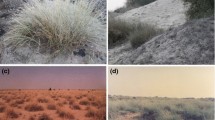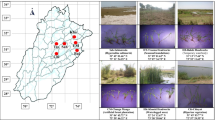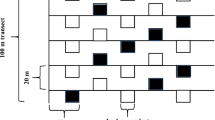Abstract
Three species ofEuphorbia (E. granulata, E. prostrata andE. hirta) exhibited both morphological and physiological adaptations in dry environmental conditions. High bound water, thick cuticle, dense hair covering and low stomatal index are some of the survival adaptations they developed under water stress conditions of the Indian arid zone.
Similar content being viewed by others
Literature Cited
Bannister P. (1964a): The water relations of certain heath plants with reference to their ecological amplitude. II. Field studies.—J. Ecol., Oxford, 52: 481–490.
Bannister P. (1964b): The water relations of certain heath plants with reference to their ecological amplitude. III. Experimental studies; General conclusion.—J. Ecol., Oxford, 52: 499–509.
Hsiao T. C. (1973): Plant responses to water stress.—Ann. Rev. Pl. Physiol., Palo Alto (California), 24: 519–570.
Iljin W. S. (1957): Drought resistance in plants and physiological process.—Ann. Rev. Pl. Physiol., Palo Alto (California), 8: 257–274.
Jha P. K. etSen D. N. (1980): Drought avoidance byCyperus rotundus.—Folia Geobot. Phytotax., Praha, 15: 387–394.
Jha P. K. etSen D. N. (1982): Adaptation and survival strategies inCyperus rotundus L.— 69th Indian Sci. Cong., Mysore, p.—192.
Lange O. L., Kappen L. etSchulze E. D. (eds.) (1976): Water and plant life—problems and modern approaches.—Berlin, Heidelberg, New York.
Levitt J. (1956) Significance of hydration to the state of protoplasm. In: Encyclopaedia of plant physiology III. (ed.)W. Ruhland, Berlin, pp. 650–651.
Martin E. V. (1943): Studies of evaporation and transpiration under controlled conditions.— Carnegie Institution Publication, Washington, D. C., 550: 48.
Maximov N. A. (1929): The plant in relation to water.—London.
Mathur T. etSen D. N. (1972): Ecology of Indian desert VIII; on the water relations and assimilate balance of some dssert plants.—Ann. Arid Zone, Jodhpur (India), 2: 18–30.
Migahid A. M. (1944): Binding of water in xerophytes and its relation to osmotic pressure.—Bull. Fac. Sci. Fouad I. Univ. Cairo, 25: 81–93.
Schonbeck M. W. etNorton T. A. (1979): An investigation of drought avoidance in intertidal algae.—Bot. Marina, New York, 22: 133–144.
Sen D. N. (1972): Water relations of a psammophyte—Convolvulus microphyllus Sieb. ex.Spreng. In: Ecophysiological Foundation of Ecosystems Productivity in Arid zone.—International Symposium USSR, Moscow, pp. 79–83.
Sen D. N. (1973): Ecology of Indian desert III: Survival adaptations of vegetation in dry environment. —Vegetatio, Amsterdam, 27: 201–265.
Sen D N. (1977): Ecophysiological studies on weeds of cultivated fields with special reference to bajra (Pennisetum typhoideum) (Rich.) and til (Sesamum indicum Linn.) crops. IIIrd Progress Report, US PL-480 Project, Univ. of Jodhpur, Jodhpur.
Sen D. N. (1978): Concepts in Indian ecology.—Jullundur (India).
Sen D. N. etBhandari M. C. (1975): On the ecology of a perennial cucurbit in the arid zone—Citrullus colocynthis (Linn.) Schard.—Inter. J. Biometeor., Lisse (Netherland), 18 (2): 113–120.
Sen D. N. etBhandari M. C. (1978): Ecology and water relations of twoCitrullus spp. in Indian arid zone.—Environ. Physiol. Ecol. Plants, (eds.)D. N. Sen etR. P. Bansal, Bishen Singh M. Pal Singh, New Delhi (India), pp 203–208.
Sen D. N., Bohra P. N. etBhati P. R. (1979): Water regimes and drought tolerence of three arid zone weeds.—J. Indian Bot. Soc., Lucknow, 58: 120–128.
Sen D. N. etChawan D. D. (1972): LeaflessEuphorbia on Rajasthan (India) rocks. IV. Water relations of seedlings and adult plants.—Vegetatio, Amsterdam, 24: 193–214.
Shreve F. (1934): The problems of the desert.—Sci. Mon. March, Tucson, pp 199–209.
Slatyer R. O. (1965): Efficiency of water utilization by arid zone vegetation.—Ann. Arid Zone, Jodhpur (India), 3: 1–12.
Stocker O. (1929): Das Wasserdefizit von Gefässpflanzen in verschiedenen Klimazonen.— Planta, Berlin, 7: 382–387.
Vadia Y., Raney F. C. etHagen R. M. (1961): Plant water deficit and physiological processes. —Ann. Rev. Plant. Physiol., Palo Alto (California), 12: 265–292.
Vogel S. (1968): “Sun leaves” and “Shade leaves” differences in convective heat dissipation.— Ecology, Durham, 49: 1203–1204.
Weatherley P. E. (1950): Studies in the water relations of the cotton plant. I. The field measurements of water deficits in leaves.—New Phytol., London, 49: 81–97.
Yapp R. H. (1909): On stratification in the vegetation of marsh and its relation to evaporation and temperature.—Ann. Bot., London, 23: 275–319.
Author information
Authors and Affiliations
Rights and permissions
About this article
Cite this article
Kumar, S., Sen, D.N. Survival adaptations of threeEuphorbia spp. in arid ecosystem. Folia geobot. phytotax. 20, 57–66 (1985). https://doi.org/10.1007/BF02856465
Received:
Issue Date:
DOI: https://doi.org/10.1007/BF02856465




